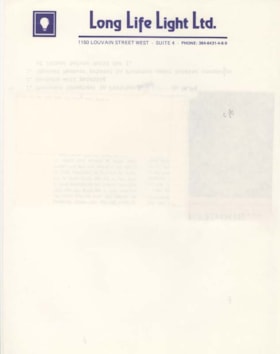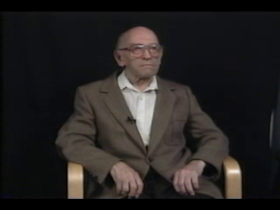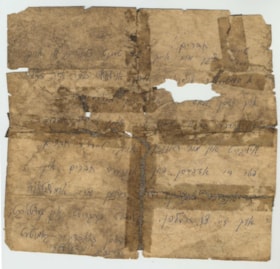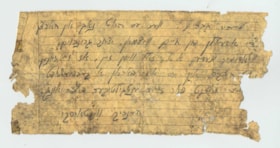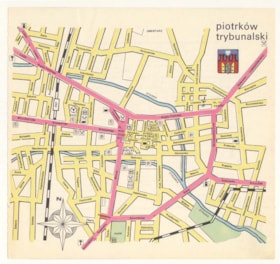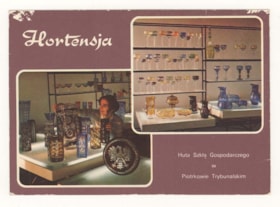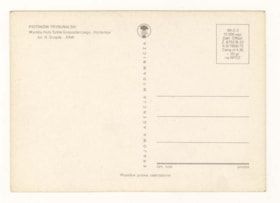Narrow Results By
Book clipping
https://www.cjhn.ca/link/cjhn59785
- Collection
- Montreal Holocaust Museum
- Description Level
- Item
- Material Type
- textual record
- Physical Description
- Book clipping : Paper : Printed : Ink : White, beige, black, navy ; Ht: 28 cm x W: 21 cm
- Collection
- Montreal Holocaust Museum
- Description Level
- Item
- Material Type
- textual record
- Physical Description
- Book clipping : Paper : Printed : Ink : White, beige, black, navy ; Ht: 28 cm x W: 21 cm
- Other Title Information
- Documentary Artifact
- Physical Condition
- Good
- Language
- Hebrew
- Notes
- Single-sided blank page with Long Life Light Ltd. letterhead printed across top. Two newspaper and book clippings taped to opposite side with typed descriptions. One of the three clippings listed has been removed. First remaining clipping shows an Eastern wall mural and the other is a Shavuot Machzor prayer printed in Piotrkow, Poland, during the Russian occupation. Narrative: Charles Kotkowsky was born in Piotrkow, Poland, in 1920. He was the son of a butcher, and had three siblings. He tried to immigrate to the USA as the Nazi persecution of Jews began, but he was unable to get the necessary documents in time. Meanwhile, he worked as a tailor in Lodz. The Germans entered Lodz on 1939/9/5 and had set up a ghetto by October. Charles worked in a glass factory, but eventually enlisted to avoid being used for forced labour. The Germans began rounding up Jews around Jewish holidays for labour or small transports for Auschwitz and Treblinka. At this time, he began receiving packages of letters and money from Ignac Samsonowicz, his old Yiddish teacher. The glass factory became a labour camp where Charles and his brother worked until they were sent to Czestochowa labour camp in November 1944. They made bullets in the factory there. The women in the glass factory were sent to Ravensbrück. Later Charles was sent to Buchenwald, where he and his friends were assigned easy jobs because their supervisor was a resistance sympathizer. Charles met Leon Blum before he was moved to Flossenburg. On their last transport train Charles and his brother jumped from the train along with many other Jews (some of which were shot in the attempt) and were sheltered in a Czechoslovakian town until the American army arrived. He moved to Italy where he worked as a translator, mostly in doctor's offices. He moved to Canada in 1951.He married Sally Blum, and they had two children, Pearl Levine and Rickie Cohen. Charles died from cancer on 2003/2/8 in Toronto, Canada.
- Accession No.
- 1998.7.25
- Name Access
- Kotkowsky, Charles
- Archival / Genealogical
- Archival Descriptions
- Repository
- Montreal Holocaust Museum
Images
Jewish Prewar Poland
https://www.cjhn.ca/link/cjhn59570
- Collection
- Montreal Holocaust Museum
- Description Level
- Item
- Material Type
- cartographic material
- Physical Description
- Map : Paper : Printed : Ink : Beige, black. ; Ht: 24 cm x W: 21 cm
- Date
- [Later than 1945]
- Collection
- Montreal Holocaust Museum
- Description Level
- Item
- Material Type
- cartographic material
- Physical Description
- Map : Paper : Printed : Ink : Beige, black. ; Ht: 24 cm x W: 21 cm
- Other Title Information
- Documentary Artifact
- Date
- [Later than 1945]
- Physical Condition
- Good
- Language
- Hebrew
- Notes
- Single-sided page with no creases. Printing blemishes across surface, three locations marked with pen, Piotrkow Trybunalski is marked with an arrow. This is a map of the Jewish pre-war Poland. Narrative: Charles Kotkowsky was born in Piotrkow, Poland, in 1920. He was the son of a butcher, and had three siblings. He tried to immigrate to the USA as the Nazi persecution of Jews began, but he was unable to get the necessary documents in time. Meanwhile, he worked as a tailor in Lodz. The Germans entered Lodz on 1939/9/5 and had set up a ghetto by October. Charles worked in a glass factory, but eventually enlisted to avoid being used for forced labour. The Germans began rounding up Jews around Jewish holidays for labour or small transports for Auschwitz and Treblinka. At this time, he began receiving packages of letters and money from Ignac Samsonowicz, his old Yiddish teacher. The glass factory became a labour camp where Charles and his brother worked until they were sent to Czestochowa labour camp in November 1944. They made bullets in the factory there. The women in the glass factory were sent to Ravensbrück. Later Charles was sent to Buchenwald, where he and his friends were assigned easy jobs because their supervisor was a resistance sympathizer. Charles met Leon Blum before he was moved to Flossenburg. On their last transport train Charles and his brother jumped from the train along with many other Jews (some of which were shot in the attempt) and were sheltered in a Czechoslovakian town until the American army arrived. He moved to Italy where he worked as a translator, mostly in doctor's offices. He moved to Canada in 1951.He married Sally Blum, and they had two children, Pearl Levine and Rickie Cohen. Charles died from cancer on 2003/2/8 in Toronto, Canada.
- Accession No.
- 1998.7.213
- Name Access
- Kotkowsky, Charles
- Places
- Poland, Europe
- Archival / Genealogical
- Archival Descriptions
- Repository
- Montreal Holocaust Museum
Images
KOTKOWSKY, Charles
https://www.cjhn.ca/link/genealogy78071
- Collection
- JEWISH IMMIGRANT AID SERVICES (JIAS)
- Material Type
- textual record
- Archival / Genealogical
- Genealogy Records
- Collection
- JEWISH IMMIGRANT AID SERVICES (JIAS)
- Material Type
- textual record
- File Date
- 1949-1951
- Record Source
- JIAS Montreal Immigrant Case Files 1922-1951
- Fonds No.
- I0037
- Series No.
- CA
- File No.
- 114-40342
- Restrictions
- Due to privacy laws, access to further information about this record is restricted. You may contact the Canadian Jewish Archives to learn more.
- Archival / Genealogical
- Genealogy Records
- Repository
- Canadian Jewish Archives
Kotkowsky, Charles - Oral History of a Holocaust Survivor
https://www.cjhn.ca/link/cjhn67759
- Collection
- WITNESS TO HISTORY COLLECTION (MHMC-02)
- Description Level
- Item
- Material Type
- moving images
- Physical Description
- 01:09:37
- Collection
- WITNESS TO HISTORY COLLECTION (MHMC-02)
- Description Level
- Item
- Material Type
- moving images
- Physical Description
- 01:09:37
- Language
- English
- Notes
- Charles Kotkowsky was born in Piotrkow Trybunalski, Poland on August 8, 1920. He says that he encountered significant antisemitism growing up. After the German invasion in September 1939, he was made to wear an armband identifying him as Jewish and became afraid to go outside. A ghetto was constructed almost immediately in Piotrkow Trybunalski. Charles worked in a glass factory and was in communication with a Jewish Resistance group. In 1942, he and his brother Shlomo were taken to a nearby labour camp. In November 1944, they were again transferred, first to the HASAG Pelzery, near Cz?stochowa, Poland, and then to Buchenwald in January 1945, where Charles was tormented and humiliated by being forced to strip naked in the freezing cold. Charles was taken on a death march to Floeszberg - a subdivision of Buchenwald - in Febuary 1945. The camp was incomplete, and Charles had to help in its construction. In April the camp was evacuated and the prisoners were placed on a train headed for Czechoslovakia. Along with seven other people, including his brother, Charles jumped off the train and successfully escaped. The group was hidden by sympathetic Czechoslovaks in Plzen, Czech Republic (Czechoslovakia). They were there hiding in a barn when they were liberated by the American Army on May 8, 1945. After the war, Charles mentioned that he was invited to what he described as a “séance,” where he witnessed captured S.S. men being beaten - one of whom was killed. His brother contracted tuberculosis and needed to be moved to a hospital in another town. Unfortunately, Charles could not stay with him in Czechoslovakia for long. He soon moved to a series of DP camps in Italy, working in a doctor’s office. In 1951, he was refused entry into the United States, but was accepted into Canada, arriving there that same year.
- Accession No.
- WTH-068
- Name Access
- Kotkowsky, Charles
- Archival / Genealogical
- Archival Descriptions
- Repository
- Montreal Holocaust Museum
Images
YouTube
Kotkowsky, Charles - Oral History of a Holocaust Survivor
https://www.youtube.com/embed/8hmNmz1HpGoLetter
https://www.cjhn.ca/link/cjhn59328
- Collection
- Montreal Holocaust Museum
- Description Level
- Item
- Material Type
- textual record
- Physical Description
- Letter : Paper : Handwritten : Ink : Brown, black ; Ht: 19 cm x W: 21 cm
- Date
- 1943-1944
- Collection
- Montreal Holocaust Museum
- Description Level
- Item
- Material Type
- textual record
- Physical Description
- Letter : Paper : Handwritten : Ink : Brown, black ; Ht: 19 cm x W: 21 cm
- Other Title Information
- Documentary Artifact
- Date
- 1943-1944
- Physical Condition
- Poor
- Language
- Yiddish
- Notes
- Single sided letter, creased, tears repaired with tape. This was the third illegal letter Charles Kotkowsky received from the Bund Coordinating Committee in Warsaw, while being incarcerated in a forced labour camp in Piotrkow, Poland. The signature, Henryk Wiktorksy, was a pseudonym used by the donor's teacher, Ignac Samsonowicz. It was created using the names of the two pre-war leaders of the Bund labor organization of Poland, Henryk Erlich and Wiktor Alter. Narrative: Charles Kotkowsky was born in Piotrkow, Poland, in 1920. He was the son of a butcher, and had three siblings. He tried to immigrate to the USA as the Nazi persecution of Jews began, but he was unable to get the necessary documents in time. Meanwhile, he worked as a tailor in Lodz. The Germans entered Lodz on 1939/9/5 and had set up a ghetto by October. Charles worked in a glass factory, but eventually enlisted to avoid being used for forced labour. The Germans began rounding up Jews around Jewish holidays for labour or small transports for Auschwitz and Treblinka. At this time, he began receiving packages of letters and money from Ignac Samsonowicz, his old Yiddish teacher. The glass factory became a labour camp where Charles and his brother worked until they were sent to Czestochowa labour camp in November 1944. They made bullets in the factory there. The women in the glass factory were sent to Ravensbrück. Later Charles was sent to Buchenwald, where he and his friends were assigned easy jobs because their supervisor was a resistance sympathizer. Charles met Leon Blum before he was moved to Flossenberg. On their last transport train Charles and his brother jumped from the train along with many other Jews (some of which were shot in the attempt) and were sheltered in a Czechoslovakian town until the American army arrived. He moved to Italy where he worked as a translator, mostly in doctor's offices. He moved to Canada in 1951.He married Sally Blum, and they had two children, Pearl Levine and Rickie Cohen. Charles died from cancer on 2003/2/8 in Toronto, Canada.
- Accession No.
- 1998.7.33
- Name Access
- Kotkowsky, Charles
- Places
- Warsaw, Poland, Europe
- Archival / Genealogical
- Archival Descriptions
- Repository
- Montreal Holocaust Museum
Images
Letter
https://www.cjhn.ca/link/cjhn59336
- Collection
- Montreal Holocaust Museum
- Description Level
- Item
- Material Type
- textual record
- Physical Description
- Letter : Paper : Handwritten : Ink : Brown, black ; Ht: 13 cm x W: 19 cm
- Date
- 1943-1944
- Collection
- Montreal Holocaust Museum
- Description Level
- Item
- Material Type
- textual record
- Physical Description
- Letter : Paper : Handwritten : Ink : Brown, black ; Ht: 13 cm x W: 19 cm
- Other Title Information
- Documentary Artifact
- Date
- 1943-1944
- Physical Condition
- Poor
- Language
- Yiddish
- Notes
- Single sided letter, creased, tears repaired with tape. This was the second illegal letter Charles Kotkowsky received from the Bund Coordinating Committee in Warsaw, while being incarcerated in a forced labour camp in Piotrkow, Poland. The letter was brought to the camp by the courier Vladka Meed. The signature, Henryk Wiktorksy, was a pseudonym used by the donor's teacher, Ignac Samsonowicz. It was created using the names the two pre-war leaders of the Bund labor organization of Poland, Henryk Erlich and Wiktor Alter. Narrative: Charles Kotkowsky was born in Piotrkow, Poland, in 1920. He was the son of a butcher, and had three siblings. He tried to immigrate to the USA as the Nazi persecution of Jews began, but he was unable to get the necessary documents in time. Meanwhile, he worked as a tailor in Lodz. The Germans entered Lodz on 1939/9/5 and had set up a ghetto by October. Charles worked in a glass factory, but eventually enlisted to avoid being used for forced labour. The Germans began rounding up Jews around Jewish holidays for labour or small transports for Auschwitz and Treblinka. At this time, he began receiving packages of letters and money from Ignac Samsonowicz, his old Yiddish teacher. The glass factory became a labour camp where Charles and his brother worked until they were sent to Czestochowa labour camp in November 1944. They made bullets in the factory there. The women in the glass factory were sent to Ravensbrück. Later Charles was sent to Buchenwald, where he and his friends were assigned easy jobs because their supervisor was a resistance sympathizer. Charles met Leon Blum before he was moved to Flossenburg. On their last transport train Charles and his brother jumped from the train along with many other Jews (some of which were shot in the attempt) and were sheltered in a Czechoslovakian town until the American army arrived. He moved to Italy where he worked as a translator, mostly in doctor's offices. He moved to Canada in 1951.He married Sally Blum, and they had two children, Pearl Levine and Rickie Cohen. Charles died from cancer on 2003/2/8 in Toronto, Canada.
- Accession No.
- 1998.7.32
- Name Access
- Kotkowsky, Charles
- Places
- Warsaw, Poland, Europe
- Archival / Genealogical
- Archival Descriptions
- Repository
- Montreal Holocaust Museum
Images
Letter
https://www.cjhn.ca/link/cjhn59337
- Collection
- Montreal Holocaust Museum
- Description Level
- Item
- Material Type
- textual record
- Physical Description
- Letter : Paper : Handwritten : Ink : Beige, brown, black. ; Ht: 9 cm x W: 18 cm
- Date
- 1943
- Collection
- Montreal Holocaust Museum
- Description Level
- Item
- Material Type
- textual record
- Physical Description
- Letter : Paper : Handwritten : Ink : Beige, brown, black. ; Ht: 9 cm x W: 18 cm
- Other Title Information
- Documentary Artifact
- Date
- 1943
- Physical Condition
- Poor
- Language
- Yiddish
- Notes
- Written on ruled paper. This was the first illegal letter Mr. Charles Kotkowsky received from the Bund Coordinating Committee in Warsaw, while being incarcerated in a forced labour camp in Piotrkow, Poland. It was delivered to him by a Polish guard in 1943. The signature, Henryk Wiktorksy, was a pseudonym used by the donor's teacher, Ignac Samsonowicz. It was created using the names the two pre-war leaders of the Bund labor organization of Poland, Henryk Erlich and Wiktor Alter. Narrative: Charles Kotkowsky was born in Piotrkow, Poland, in 1920. He was the son of a butcher, and had three siblings. He tried to immigrate to the USA as the Nazi persecution of Jews began, but he was unable to get the necessary documents in time. Meanwhile, he worked as a tailor in Lodz. The Germans entered Lodz on 1939/9/5 and had set up a ghetto by October. Charles worked in a glass factory, but eventually enlisted to avoid being used for forced labour. The Germans began rounding up Jews around Jewish holidays for labour or small transports for Auschwitz and Treblinka. At this time, he began receiving packages of letters and money from Ignac Samsonowicz, his old Yiddish teacher. The glass factory became a labour camp where Charles and his brother worked until they were sent to Czestochowa labour camp in November 1944. They made bullets in the factory there. The women in the glass factory were sent to Ravensbrück. Later Charles was sent to Buchenwald, where he and his friends were assigned easy jobs because their supervisor was a resistance sympathizer. Charles met Leon Blum before he was moved to Flossenburg. On their last transport train Charles and his brother jumped from the train along with many other Jews (some of which were shot in the attempt) and were sheltered in a Czechoslovakian town until the American army arrived. He moved to Italy where he worked as a translator, mostly in doctor's offices. He moved to Canada in 1951.He married Sally Blum, and they had two children, Pearl Levine and Rickie Cohen. Charles died from cancer on 2003/2/8 in Toronto, Canada.
- Accession No.
- 1998.7.31
- Name Access
- Kotkowsky, Charles
- Places
- Warsaw, Poland, Europe
- Archival / Genealogical
- Archival Descriptions
- Repository
- Montreal Holocaust Museum
Images
Letter
https://www.cjhn.ca/link/cjhn59340
- Collection
- Montreal Holocaust Museum
- Description Level
- Item
- Material Type
- textual record
- Physical Description
- Letter : Paper : Handwritten : Ink : Beige, brown, black ; Ht: 12 cm x W: 18 cm
- Date
- 1943-1944
- Collection
- Montreal Holocaust Museum
- Description Level
- Item
- Material Type
- textual record
- Physical Description
- Letter : Paper : Handwritten : Ink : Beige, brown, black ; Ht: 12 cm x W: 18 cm
- Other Title Information
- Documentary Artifact
- Date
- 1943-1944
- Physical Condition
- fragile
- Language
- Polish
- Notes
- Single-sided letter on ruled paper, creased down center. Fourth illegal letter sent from the Bund Coordinating Committee in Warsaw to Charles Kotkowsky in forced labour camp of Piotrkow. The delivery of this letter was difficult. The courier Ala Margules was arrested with the money, after this letter was delivered to Renia Zaks. Ultimately Ala Margules was saved from the Germans by bribing a Volksdeutsche Kommandant with 10.000 Zlotys from the 50.000 Zlotys that Vladka Meed had brought previously. The signature, Henryk Wiktorksy, was a pseudonym used by the donor's teacher, Ignac Samsonowicz. It was created using the names the two pre-war leaders of the Bund labor organization of Poland, Henryk Erlich and Wiktor Alter. Narrative: Charles Kotkowsky was born in Piotrkow, Poland, in 1920. He was the son of a butcher, and had three siblings. He tried to immigrate to the USA as the Nazi persecution of Jews began, but he was unable to get the necessary documents in time. Meanwhile, he worked as a tailor in Lodz. The Germans entered Lodz on 1939/9/5 and had set up a ghetto by October. Charles worked in a glass factory, but eventually enlisted to avoid being used for forced labour. The Germans began rounding up Jews around Jewish holidays for labour or small transports for Auschwitz and Treblinka. At this time, he began receiving packages of letters and money from Ignac Samsonowicz, his old Yiddish teacher. The glass factory became a labour camp where Charles and his brother worked until they were sent to Czestochowa labour camp in November 1944. They made bullets in the factory there. The women in the glass factory were sent to Ravensbrück. Later Charles was sent to Buchenwald, where he and his friends were assigned easy jobs because their supervisor was a resistance sympathizer. Charles met Leon Blum before he was moved to Flossenburg. On their last transport train Charles and his brother jumped from the train along with many other Jews (some of which were shot in the attempt) and were sheltered in a Czechoslovakian town until the American army arrived. He moved to Italy where he worked as a translator, mostly in doctor's offices. He moved to Canada in 1951.He married Sally Blum, and they had two children, Pearl Levine and Rickie Cohen. Charles died from cancer on 2003/2/8 in Toronto, Canada.
- Accession No.
- 1998.7.34
- Name Access
- Kotkowsky, Charles
- Places
- Warsaw, Poland, Europe
- Archival / Genealogical
- Archival Descriptions
- Repository
- Montreal Holocaust Museum
Images
Outposts of the concentration camp Buchenwald
https://www.cjhn.ca/link/cjhn59569
- Collection
- Montreal Holocaust Museum
- Description Level
- Item
- Material Type
- cartographic material
- Physical Description
- Map : Paper : Printed : Ink : White, black ; Ht: 21 cm x W: 28 cm
- Collection
- Montreal Holocaust Museum
- Description Level
- Item
- Material Type
- cartographic material
- Physical Description
- Map : Paper : Printed : Ink : White, black ; Ht: 21 cm x W: 28 cm
- Other Title Information
- Documentary Artifact
- Physical Condition
- Good
- Language
- German
- Notes
- Single sided page with map of Germany printed on front. Map shows all outposts of the concentration camp Buchenwald. Flossenburg, the camp Charles was sent to after Buchenwald, is indicated with an arrow. Narrative: Charles Kotkowsky was born in Piotrkow, Poland, in 1920. He was the son of a butcher, and had three siblings. He tried to immigrate to the USA as the Nazi persecution of Jews began, but he was unable to get the necessary documents in time. Meanwhile, he worked as a tailor in Lodz. The Germans entered Lodz on 1939/9/5 and had set up a ghetto by October. Charles worked in a glass factory, but eventually enlisted to avoid being used for forced labour. The Germans began rounding up Jews around Jewish holidays for labour or small transports for Auschwitz and Treblinka. At this time, he began receiving packages of letters and money from Ignac Samsonowicz, his old Yiddish teacher. The glass factory became a labour camp where Charles and his brother worked until they were sent to Czestochowa labour camp in November 1944. They made bullets in the factory there. The women in the glass factory were sent to Ravensbrück. Later Charles was sent to Buchenwald, where he and his friends were assigned easy jobs because their supervisor was a resistance sympathizer. Charles met Leon Blum before he was moved to Flossenburg. On their last transport train Charles and his brother jumped from the train along with many other Jews (some of which were shot in the attempt) and were sheltered in a Czechoslovakian town until the American army arrived. He moved to Italy where he worked as a translator, mostly in doctor's offices. He moved to Canada in 1951.He married Sally Blum, and they had two children, Pearl Levine and Rickie Cohen. Charles died from cancer on 2003/2/8 in Toronto, Canada.
- Accession No.
- 1998.7.212
- Name Access
- Kotkowsky, Charles
- Places
- Germany, Europe
- Archival / Genealogical
- Archival Descriptions
- Repository
- Montreal Holocaust Museum
Images
Piotrkow Trybunalski
https://www.cjhn.ca/link/cjhn59568
- Collection
- Montreal Holocaust Museum
- Description Level
- Item
- Material Type
- cartographic material
- Physical Description
- Map : Paper : Printed : Ink : Pink, blue, beige, green ; Ht: 19 cm x W: 20 cm
- Collection
- Montreal Holocaust Museum
- Description Level
- Item
- Material Type
- cartographic material
- Physical Description
- Map : Paper : Printed : Ink : Pink, blue, beige, green ; Ht: 19 cm x W: 20 cm
- Other Title Information
- Documentary Artifact
- Physical Condition
- Good
- Language
- Polish
- Notes
- Double sided page, no creases, tear down left side where page was torn from source. Coloured street map of Piotrkow Trybunalski. On the back, tourist destinations indicated with contact information, legend, and address. The house of Charles Kotkowsky is marked with pen arrow. Narrative: Charles Kotkowsky was born in Piotrkow, Poland, in 1920. He was the son of a butcher, and had three siblings. He tried to immigrate to the USA as the Nazi persecution of Jews began, but he was unable to get the necessary documents in time. Meanwhile, he worked as a tailor in Lodz. The Germans entered Lodz on 1939/9/5 and had set up a ghetto by October. Charles worked in a glass factory, but eventually enlisted to avoid being used for forced labour. The Germans began rounding up Jews around Jewish holidays for labour or small transports for Auschwitz and Treblinka. At this time, he began receiving packages of letters and money from Ignac Samsonowicz, his old Yiddish teacher. The glass factory became a labour camp where Charles and his brother worked until they were sent to Czestochowa labour camp in November 1944. They made bullets in the factory there. The women in the glass factory were sent to Ravensbrück. Later Charles was sent to Buchenwald, where he and his friends were assigned easy jobs because their supervisor was a resistance sympathizer. Charles met Leon Blum before he was moved to Flossenburg. On their last transport train Charles and his brother jumped from the train along with many other Jews (some of which were shot in the attempt) and were sheltered in a Czechoslovakian town until the American army arrived. He moved to Italy where he worked as a translator, mostly in doctor's offices. He moved to Canada in 1951.He married Sally Blum, and they had two children, Pearl Levine and Rickie Cohen. Charles died from cancer on 2003/2/8 in Toronto, Canada.
- Accession No.
- 1998.7.211
- Name Access
- Kotkowsky, Charles
- Archival / Genealogical
- Archival Descriptions
- Repository
- Montreal Holocaust Museum
Images
Postcard
https://www.cjhn.ca/link/cjhn59567
- Collection
- Montreal Holocaust Museum
- Description Level
- Item
- Material Type
- textual record
- Physical Description
- Postcard : Paper : Printed : Ink : Burgundy, beige, brown, amber, black ; Ht: 10 cm x W: 15 cm
- Date
- 1990
- Collection
- Montreal Holocaust Museum
- Description Level
- Item
- Material Type
- textual record
- Physical Description
- Postcard : Paper : Printed : Ink : Burgundy, beige, brown, amber, black ; Ht: 10 cm x W: 15 cm
- Other Title Information
- Documentary Artifact
- Date
- 1990
- Physical Condition
- Good
- Language
- Polish
- Notes
- Postcard format card with image on front and back divided between description, space for brief message, and address. Unused postcard contains images from a local glass artisan shop in Piotrkow Trybunalski, Poland. Narrative: Charles Kotkowsky was born in Piotrkow, Poland, in 1920. He was the son of a butcher, and had three siblings. He tried to immigrate to the USA as the Nazi persecution of Jews began, but he was unable to get the necessary documents in time. Meanwhile, he worked as a tailor in Lodz. The Germans entered Lodz on 1939/9/5 and had set up a ghetto by October. Charles worked in a glass factory, but eventually enlisted to avoid being used for forced labour. The Germans began rounding up Jews around Jewish holidays for labour or small transports for Auschwitz and Treblinka. At this time, he began receiving packages of letters and money from Ignac Samsonowicz, his old Yiddish teacher. The glass factory became a labour camp where Charles and his brother worked until they were sent to Czestochowa labour camp in November 1944. They made bullets in the factory there. The women in the glass factory were sent to Ravensbrück. Later Charles was sent to Buchenwald, where he and his friends were assigned easy jobs because their supervisor was a resistance sympathizer. Charles met Leon Blum before he was moved to Flossenburg. On their last transport train Charles and his brother jumped from the train along with many other Jews (some of which were shot in the attempt) and were sheltered in a Czechoslovakian town until the American army arrived. He moved to Italy where he worked as a translator, mostly in doctor's offices. He moved to Canada in 1951.He married Sally Blum, and they had two children, Pearl Levine and Rickie Cohen. Charles died from cancer on 2003/2/8 in Toronto, Canada.
- Accession No.
- 1998.7.29
- Name Access
- Kotkowsky, Charles
- Archival / Genealogical
- Archival Descriptions
- Repository
- Montreal Holocaust Museum
Images
{{ server.message }}


